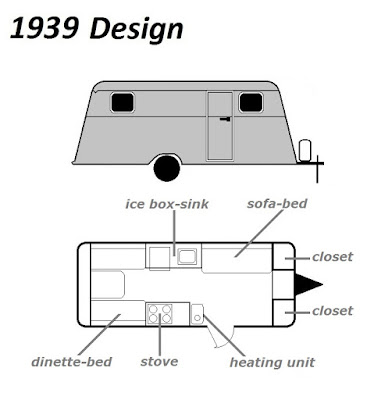The global conflict of the first half of the 1940s created a pronounced housing shortage and mass market for the trailer coach. In the flurry to supply wartime housing for defense plant workers, rigs were built out of whatever materials were available.
Workers assemble emergency housing for defense plant workers at the Western Trailer Company, in Los Angeles. The date, June 1942.
Photo from Library of Congress / David Bransby
Like California's Western Trailer Company, Michigan's Alma Trailer Company manufactured emergency housing for defense plant workers. Often, house trailer caravans would be seen, which were enroute to various defense worker camps around the nation.
In an image dating to March 1941, a trailer caravan crosses the Potomac River into Virginia.
Photo from Library of Congress / Roydan Dixon
A negative image of trailer life, fostered by the economic crash of the 1930s, was refueled by the perception of the emergency wartime trailer as a slipshod and second-rate housing option.
At the same time, the big promotional buzz word of the 1940s was LIVEABILITY. There could be room to spare in quarters no larger that 200 square feet...or so an advertisement of the time might have said.
With a severe housing shortage at hand, a mid-century family was thankful, indeed, to have a tiny, cramped trailer coach to call home.
A snapshot from February 1942 shows a trailerite family who live at the Farm Security Administration's Sunnyside trailer camp. The father works at the adjacent Burlington, Iowa defense plant.
Photo from Library of Congress / John Vachon
Naturally, super-compact designs made sure that every inch of interior space was used in the most efficient manner possible!
Here we see another wartime trailerite family. The father is also employed at the Burlington, Iowa facility.
Photo from Library of Congress / John Vachon
In this image from May 1941, we view a Farm Security Administration trailer camp, which houses workers at a Nashville, Tennessee defense plant.
Photo from Library of Congress / Peter Saeker
The American public's negative house trailer perception began to improve after the war. Superbly-crafted coaches were being built by manufacturers such as Schult, Spartan and, eventually, Detroiter. These, and other well-built rigs, were marketed to returning GIs and their wives as a quick and economical way to achieve the American Dream of home ownership.
A typical post-war unit is depicted above. Now officially known as "mobile homes," rigs extend for up to 40 feet, with the standard width being 8 feet.
In the late 1940s, bathroom facilities were available in a new mobile home, but were a deluxe feature. If there was a bathroom, it probably wasn't a complete one, with commode, lavatory and bath tub.
3/4, or "shower baths" became a standard mobile home component with the 1951 model year. By the mid-1950s, most newly-built rigs included a full bathroom.




















































